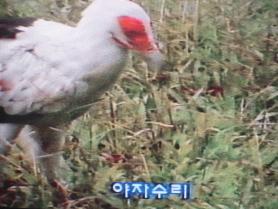|
| Query: Red kite | Result: 37th of 51 | |
Palm-nut Vulture (2/5)
| Subject: | Palm-nut Vulture (2/5)
| | Poster: | Jinsuk Kim (jinsuk@mailandnews.com)
| |

| File size : 13957 bytes
File date : 2001:01:03 14:24:07
Resolution: 278x209
Jpeg process : Baseline
Posted Newsgroups: alt.binaries.pictures.animals
Posted Date: Wed, 03 Jan 2001 05:04:50 GMT |
Palm-nut Vulture (Gypohierax angolensis)
I took a TV documentary with my digital camera.
Though the quality is very poor, I hope you enjoy
this rarely-posted bird of prey.
Jinsuk
filename="Palm-nut_Vulture_js002.jpg"
|
Comments |
|---|
| | Guest |
|
Palm-nut Vulture (Gypohierax angolensis) is a very large bird of prey in the family Accipitridae which also includes many other diurnal raptors such as kites, buzzards and harriers. It is the only member of the genus Gypohierax.
This bird is an Old World vulture, and is not related to the New World vultures which are in a separate family, Cathartidae.
It breeds in forest and savannah across sub-Saharan Africa, usually near water, its range coinciding with that of the Oil Palm. It is quite approachable, like many African vultures, and can be seen near habitation, even on large hotel lawns in the tourist areas of countries like The Gambia.
This is an unmistakable bird as an adult. Its plumage is all white except for black areas in its wings. It has a red patch around the eye. The immature, which takes 5 years to mature, is brown with a yellow eye patch. In flight this species resembles an eagle more than a typical vulture, and it can sustain flapping flight, so it does not depend on thermals.
This vulture gets its name from its favourite food, which, uniquely for a bird of prey, is not meat, but the nut of the Oil Palm. It will also take dead fish.
Birds may form loose colonies. A single egg is incubated in a bulky stick nest in a tree for about six weeks. |
| | Guest |
|
Scientific Name: Gypohierax angolensis (Gmelin, 1788)
Common Names:
English – Palm-nut Vulture, vulturine fish eagle
French – Vautour palmiste
French: Palmiste africain German: Palmgeier Spanish: Buitre palmero
Taxonomy: Falco angolensis J. F. Gmelin, 1788, Angola. |
^o^
Animal Pictures Archive for smart phones
^o^
|
|
|

